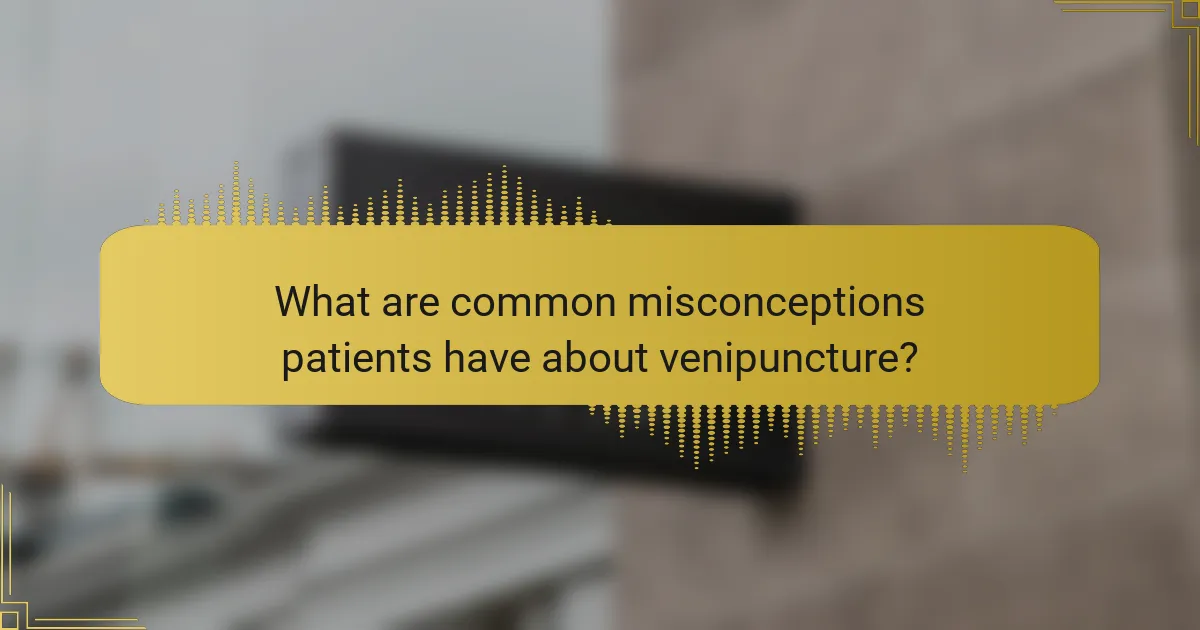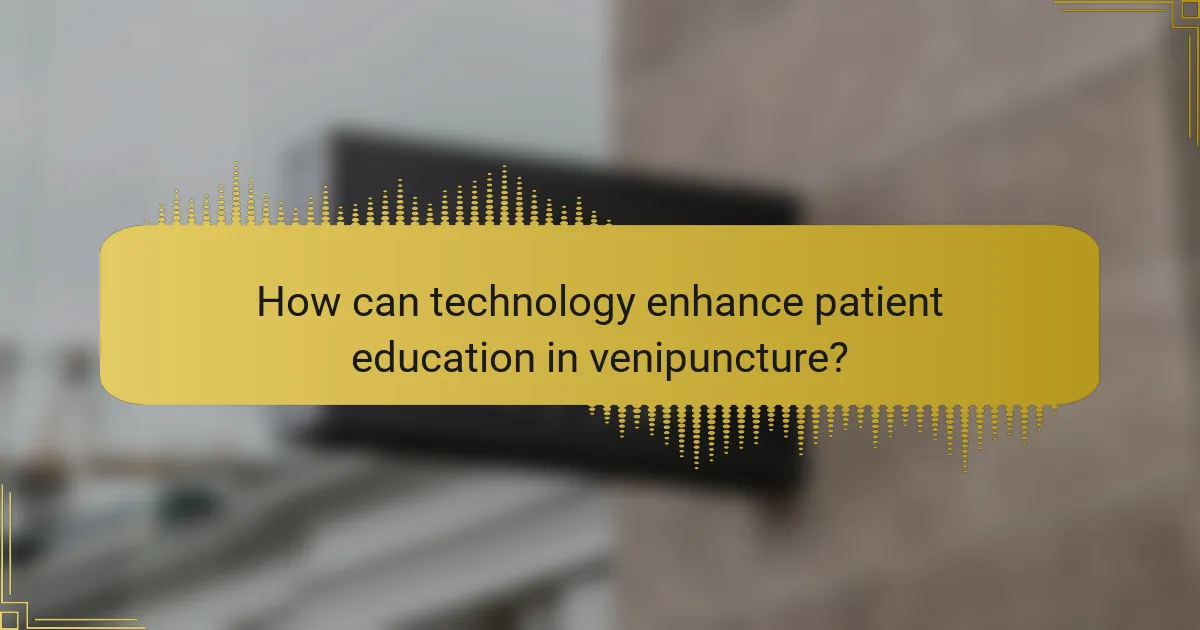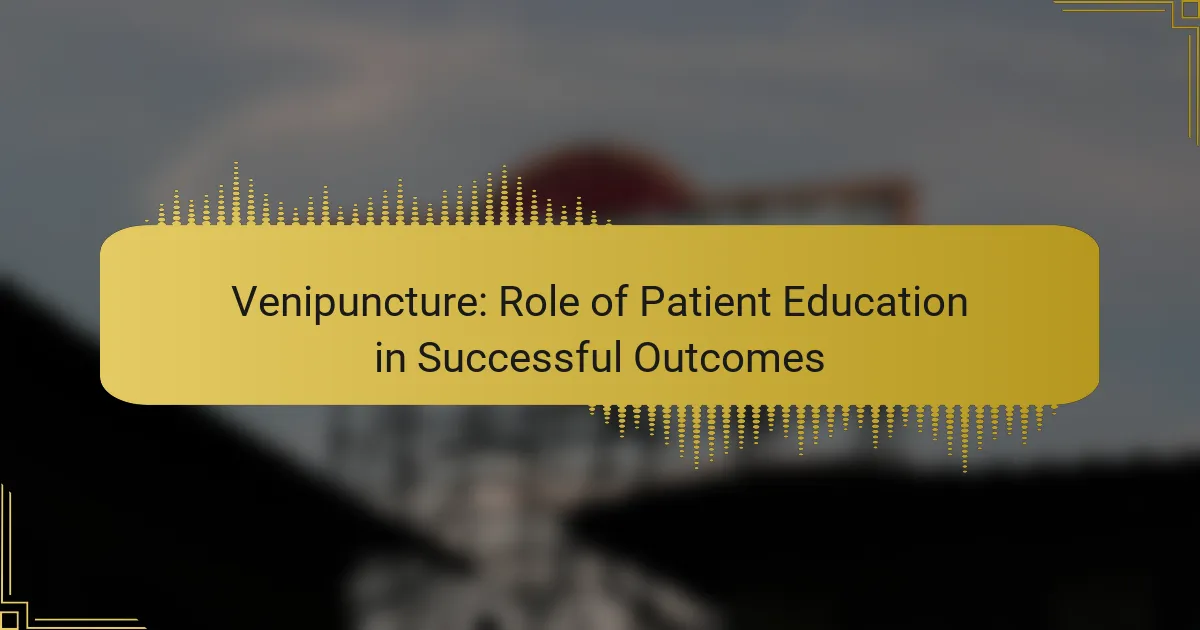Patient education plays a crucial role in enhancing the success of venipuncture by promoting understanding and cooperation among patients. When individuals are well-informed about the procedure, they experience reduced anxiety and are more likely to engage positively, leading to fewer complications and a smoother overall experience.

How does patient education improve venipuncture outcomes in Canada?
Patient education significantly enhances venipuncture outcomes in Canada by fostering better cooperation and understanding among patients. When patients are well-informed about the procedure, they are more likely to engage positively, leading to fewer complications and a smoother experience.
Increased patient cooperation
Educated patients are more likely to cooperate during venipuncture, which can lead to improved success rates. When patients understand the importance of staying still and following instructions, they contribute to a more efficient process.
For instance, a patient who knows what to expect is less likely to resist or panic, allowing healthcare providers to perform the procedure with greater ease.
Reduced anxiety levels
Providing clear information about venipuncture can significantly reduce patient anxiety. When patients are aware of the steps involved and the reasons behind them, they feel more in control and less fearful.
Techniques such as pre-procedure discussions or informational brochures can help alleviate concerns, making the experience less daunting.
Enhanced understanding of procedures
Patient education ensures that individuals have a clear understanding of the venipuncture process. This includes knowing why the procedure is necessary and what it entails, which can demystify the experience.
For example, explaining the purpose of blood tests and how they can impact health decisions can motivate patients to participate actively in their care.
Better adherence to pre-procedure instructions
When patients are educated about pre-procedure requirements, such as fasting or hydration, they are more likely to follow these guidelines. Adherence to instructions can lead to more accurate test results and fewer delays.
Healthcare providers can enhance compliance by clearly communicating these instructions and the rationale behind them, ensuring patients understand their importance.
Improved overall satisfaction
Patient education contributes to higher satisfaction levels regarding the venipuncture experience. When patients feel informed and involved, they are more likely to report positive experiences.
Surveys often indicate that patients who receive thorough explanations and support during procedures express greater satisfaction with their care, which can lead to increased trust in healthcare providers.

What are effective patient education strategies for venipuncture?
Effective patient education strategies for venipuncture include using visual aids, demonstrating the procedure, providing written materials, and offering one-on-one consultations. These methods help patients understand the process, reduce anxiety, and improve overall satisfaction with their healthcare experience.
Use of visual aids
Visual aids, such as diagrams or videos, can significantly enhance patient understanding of venipuncture. They provide a clear representation of the procedure, helping patients visualize what to expect. This can alleviate fear and promote a sense of control.
When using visual aids, ensure they are simple and directly related to the venipuncture process. For example, a step-by-step infographic can guide patients through the procedure, highlighting key points like site preparation and needle insertion.
Demonstration of the procedure
Demonstrating the venipuncture procedure can be an effective way to educate patients. A healthcare professional can perform a mock procedure on a model or a willing participant, explaining each step as they go. This hands-on approach can demystify the process and reduce anxiety.
Consider allowing patients to observe the demonstration closely, as this can help them feel more comfortable when it’s their turn. Encourage questions during the demonstration to address any specific concerns they may have.
Providing written materials
Providing written materials, such as brochures or handouts, allows patients to review information about venipuncture at their own pace. These materials should include details about the procedure, potential side effects, and aftercare instructions. Clear, concise language is essential.
Include visuals in the written materials to reinforce the information presented. Ensure that the materials are accessible and available in multiple languages if necessary, catering to the diverse patient population.
One-on-one consultations
One-on-one consultations offer a personalized approach to patient education about venipuncture. During these sessions, healthcare providers can address individual concerns, answer questions, and provide tailored information based on the patient’s medical history and anxiety levels.
Encourage patients to express their fears or misconceptions during these consultations. This open dialogue can lead to a better understanding of the procedure and foster a trusting relationship between the patient and healthcare provider, ultimately improving the patient’s experience.

What role do healthcare professionals play in patient education for venipuncture?
Healthcare professionals are essential in educating patients about venipuncture, which significantly influences patient comfort and procedure success. Effective communication helps patients understand what to expect, alleviating anxiety and improving cooperation during the process.
Educating patients on the procedure
Patients should receive clear information about the venipuncture procedure, including its purpose, steps involved, and potential sensations they may experience. Providing this education can help demystify the process and reduce fear. Visual aids or demonstrations can enhance understanding and retention of information.
It’s beneficial to explain the importance of hydration and how it can facilitate easier blood draws. Encouraging patients to drink water before the procedure can lead to better outcomes, as well-hydrated veins are typically easier to puncture.
Addressing patient concerns
Healthcare professionals must actively listen to and address any concerns patients may have regarding venipuncture. Common worries include pain, needle size, and potential complications. By acknowledging these fears and providing reassurance, professionals can foster a more positive experience.
Offering strategies for managing discomfort, such as deep breathing techniques or distraction methods, can also help ease patient anxiety. Providing a supportive environment where patients feel comfortable voicing their concerns is crucial for successful outcomes.
Training staff on communication techniques
Training healthcare staff in effective communication techniques is vital for enhancing patient education about venipuncture. Staff should be equipped with skills to convey information clearly and empathetically, ensuring patients feel heard and understood. Role-playing scenarios can be an effective training method.
Regular workshops focusing on patient interaction and communication can help reinforce these skills. Encouraging staff to use open-ended questions can facilitate better dialogue and allow patients to express their concerns more freely, leading to improved patient satisfaction and procedural success.

What are common misconceptions patients have about venipuncture?
Patients often have misconceptions about venipuncture, particularly regarding pain, duration, and the needle used. Many believe the process is significantly more painful and time-consuming than it actually is, which can lead to unnecessary anxiety.
Pain levels during the procedure
One common misconception is that venipuncture is extremely painful. In reality, while some discomfort is expected, most patients report only mild pain, often described as a quick pinch. Techniques such as using smaller needles and applying topical anesthetics can further reduce discomfort.
It’s important for patients to communicate with their healthcare providers about their pain tolerance and any previous experiences, as this can help tailor the approach to minimize discomfort.
Duration of the process
Patients frequently underestimate the time required for venipuncture. The actual procedure typically takes just a few minutes, although preparation and post-procedure care may extend the total time to around 15-30 minutes. Understanding this can help alleviate anxiety about waiting times.
Being informed about the quick nature of the procedure can encourage patients to approach it with less apprehension, knowing that the process is efficient and straightforward.
Needle size and its impact
Another misconception is that larger needles always mean more pain. In venipuncture, needle size can vary, and smaller needles are often used for blood draws to minimize discomfort. The gauge of the needle can impact both pain levels and the ease of blood collection.
Patients should be aware that healthcare providers select needle sizes based on the specific procedure and patient needs, aiming to balance comfort with effective blood collection. Discussing any concerns about needle size with the provider can lead to a more comfortable experience.

How can technology enhance patient education in venipuncture?
Technology can significantly improve patient education in venipuncture by providing accessible information and interactive tools. These resources help patients understand the procedure, reduce anxiety, and promote better cooperation during the process.
Mobile apps for information access
Mobile applications offer patients easy access to information about venipuncture, including preparation steps and what to expect during the procedure. Many apps feature instructional videos, FAQs, and tips for managing anxiety, which can empower patients and enhance their overall experience.
When selecting a mobile app, look for those that are user-friendly and well-reviewed. Some apps may also allow patients to track their health data, which can be beneficial for ongoing communication with healthcare providers.
